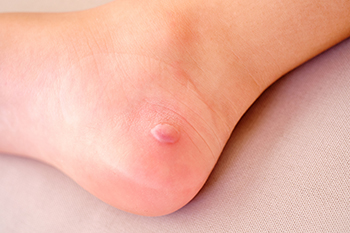
Foot blisters are often caused by friction, typically from wearing tight or poorly fitting shoes, or engaging in repetitive activities such as walking or running. These blisters act as a natural defense mechanism, forming a protective bubble of fluid to shield the underlying skin from further damage. However, if the blister’s protective layer breaks, the risk of infection increases. Signs of an infected blister include redness, warmth, pain, swelling, or the presence of pus. In severe cases, the infection can spread, leading to conditions like cellulitis, which requires immediate attention. A chiropodist can help to manage foot blisters, particularly when infection is suspected. They can safely drain the blister and clean the area antiseptically to prevent further complications. Addressing infected blisters promptly can help avoid serious health risks. If you have an infected blister on the feet, it is suggested that you schedule an appointment with a chiropodist.
Blisters can usually be treated at home, however, if you have recurring blisters or experience significant discomfort or pain, please consult with Cynthia Chan, B.Sc., D.Ch from Healthy Advantage Foot & Orthotic Clinic. Our practitioner will assess your condition and provide you with quality foot and ankle treatment.
What Is a Blister?
A blister is a small pocket of fluid in the upper skin layers and is one of the body’s natural responses to injury or pressure. Blisters can also result from burns, fungal or viral skin infections, and the feet are particularly prone due to ill-fitting footwear and friction. Friction on the skin causes the upper layer of skin to separate from the lower layers. The space that this separation creates then becomes filled with a liquid called serum, which protects the lower layers of skin.
Treatment
If you notice a blister on your foot, you can cover it with a soft bandage or dressing to protect it. Popping the blister is discouraged. Doing so exposes the raw skin underneath it to bacteria and also raises the risk of infection. If a blister pops naturally, let it drain before covering it with a bandage. Blisters usually heal on their own or with home treatment, however, if your blister is recurring, very painful, or appears infected, it is recommended that you see a chiropodist for treatment.
Prevention
You can help to prevent blisters by wearing comfortable, well-fitted shoes. Keep your feet dry by wearing moisture-wicking socks and dust your feet with talcum powder if they tend to get sweaty. If you have areas on your feet that are more susceptible to blisters, you might be able to prevent the blister from forming by covering it with a pad.
If you have any questions, please feel free to contact our office located in . We offer the newest diagnostic and treatment technologies for all your foot care needs.